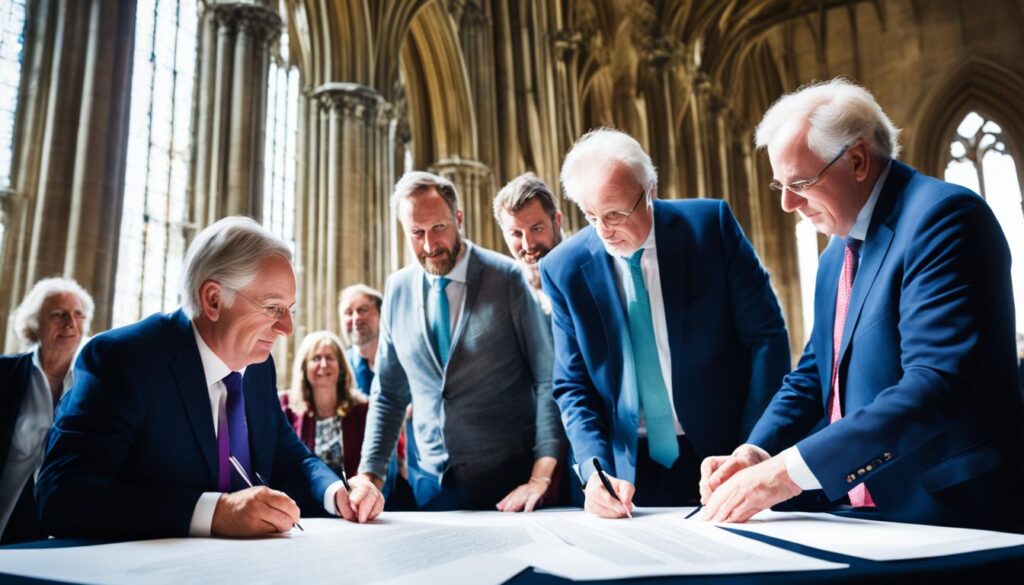The Magna Carta, signed in 1215 by King John of England, is a key moment in history. It shows the fight for democracy and human rights. This document set important principles that shaped modern democracy and protected individual rights.
This charter aimed to limit the king’s total power. It made sure people’s rights and freedoms were protected. It started the idea of the rule of law, which is key in democracies.
It put limits on the king and gave liberties to nobles and common people. This helped start the growth of democratic ideas like due process and the right to a fair trial.
The Magna Carta’s impact goes beyond England. It helped shape democratic systems and protect rights worldwide. Its ideas are seen in documents like the United States Declaration of Independence and the Bill of Rights. It still guides us on what rights and freedoms are needed for a fair society.
What is the Magna Carta?
The Magna Carta was a key document in medieval England’s history. It was made in 1215 at Runnymede, near the River Thames. It set legal rules that changed how the law worked and protected people’s rights.
Origins and Background
King John’s rule made the feudal system in England very harsh. He had too much power and unfairly taxed his people and jailed them without reason. This led the nobles to ask for changes to make things fair again.
The Magna Carta came from these talks. It aimed to fix the nobles’ and clergy’s problems and make a fairer government.
Key Principles Enshrined
The Magna Carta brought in important ideas that changed England and helped shape modern democracies. It talked about fair trials, the king’s limits, and everyone being equal under the law. It also started the idea of habeas corpus, which keeps people safe from being wrongly jailed.
It said that the king couldn’t just tax people without their agreement. These ideas were big steps towards freedom and justice.
The Magna Carta’s lasting impact shows how powerful words can be. It has helped shape human rights and the rule of law. Its ideas have been used in many other important documents, making it a key part of the fight for freedom and justice.
Historical Curiosities: Exploring the Magna Carta’s Enduring Legacy
The Magna Carta, signed in 1215, has always fascinated historians and the public. It has had a huge impact over the centuries. This old charter has changed the legal, political, and cultural scenes. It has inspired many people and groups worldwide.
One interesting thing about the Magna Carta is its effect on later documents. The charter’s ideas, like limiting king’s power and ensuring fair trials, are seen in the US Constitution and the Bill of Rights. This has made the Magna Carta a key part of modern democracy and the rule of law.
The Magna Carta has also had a big impact on politics. Its ideas have driven movements for more freedom and representative government. It has been a symbol for those fighting against too much power and for citizens’ rights in many struggles, from the American Revolution to civil rights.
But the Magna Carta has also touched popular culture. Its famous status has made it a common theme in books, movies, and even memes. This shows how it still captures our imagination and stays relevant today.
Looking into the Magna Carta’s historical curiosities helps us see its wide-ranging legacy. It has shaped legal and political systems and is still in our cultural thoughts. The Magna Carta remains a source of interest and inspiration for experts and the general public.
The Road to Rights and Liberties
The Magna Carta was a key step in limiting the English monarch’s power. It set the stage for a constitutional monarchy. This historic document protected rights and liberties, leading to representative government and individual freedom in English history.
Limiting Absolute Monarchical Power
Before the Magna Carta, the English king had total power. He made decisions without any limits. The Magna Carta, signed by King John in 1215, changed this.
It showed that the king was not above the law. The charter ensured fair trials and limited the king’s power to tax heavily. It protected the people’s rights and liberties.
The Magna Carta was a big step towards a constitutional monarchy in England. It started the move from the monarch to the people. This led to Parliament and a system where the ruler’s power was balanced.

The Magna Carta’s impact is still felt today. It has inspired similar documents worldwide. Its role in English history and the fight for democracy and human rights is huge.
Magna Carta’s Influence on Modern Democracies
The Magna Carta has left a lasting mark on modern democracies, both in the UK and globally. Its ideas of due process, the rule of law, and limiting government power are seen in many constitutions. This includes the United States Declaration of Independence and the Bill of Rights.
In the British parliamentary system, the Magna Carta’s impact is clear. It set the stage for important rights like habeas corpus, trial by jury, and the rule that no one is above the law. These ideas have shaped the UK’s legal system and have influenced other democracies too.
The fight for American independence was also influenced by the Magna Carta. The US Declaration of Independence talks about “all men are created equal” and their rights to life, liberty, and the pursuit of happiness. This reflects the Magna Carta’s focus on individual freedoms and limiting royal power.
Today, the Magna Carta still guides modern democracies. It helps shape constitutional law and protect human rights worldwide. Its lasting impact shows how powerful ideas can change history.
Challenges and Controversies Surrounding the Charter
The Magna Carta is seen as a key document of modern democracy. Yet, it has faced debates and controversies over time. Scholars and historians have struggled with its complex meanings and how it fits into changing political and social scenes.
Debates and Interpretations
Debates about the Magna Carta focus on its historical importance and legal impact. Some say its impact has been exaggerated, pointing out that many of its clauses were soon forgotten or ignored. Others believe its real value lies in inspiring the growth of rights and liberties over the years.
There’s a big debate on what the Magna Carta really means. It’s often hailed for protecting individual rights and limiting the king’s power. But, its legal and political effects are still up for grabs among scholars. Different views on certain phrases and clauses keep the debate alive, questioning its historical and modern relevance.
Despite the debates, the Magna Carta stands as a symbol of the fight for civil liberties and the rule of law. Its lasting impact continues to fuel discussions, showing the complex and deep influence of this historic document.
The Magna Carta in Popular Culture
The Magna Carta’s legacy lives on in popular culture. It appears in literature, film, art, and even merchandise. This historic charter has become a symbol in the minds of scholars and the public alike.
In literature, famous authors have used the Magna Carta. They see it as a symbol of our rights and freedoms. Works like “Ivanhoe” by Sir Walter Scott and “A Tale of Two Cities” by Charles Dickens highlight its importance.
Movies have also been inspired by the Magna Carta. Films like “Robin Hood: Prince of Thieves” and “The Lion in Winter” explore its themes. These movies make the Magna Carta’s story known to more people, sparking interest in its history.
Art has also embraced the Magna Carta. From beautiful manuscripts to modern sculptures, art shows its lasting impact. These pieces help keep the Magna Carta’s message alive and inspire people to learn more about its significance.
Merchandise has also featured the Magna Carta. You can find its seal and famous phrases on items like t-shirts and mugs. This shows how the Magna Carta still captures our imagination today.
Preserving the Magna Carta: Conservation Efforts
The Magna Carta is a key historical document that needs careful preservation. Conservation work, like storing it safely and controlling the climate, is key. This keeps it safe for future generations.
Safeguarding a Historical Treasure
The Magna Carta stands for democracy and freedom. It’s a delicate document that must be kept safe from damage. Experts use special techniques to protect it.
They control the temperature and humidity and handle it carefully. This keeps the Magna Carta in good shape for people to study and see.
Digitization is also important for the Magna Carta. By making digital copies, people can learn about it without risking the original. These digital versions help scholars and fans all over the world.
But it’s not just about keeping the document safe. Educational programs and outreach keep the Magna Carta’s spirit alive. Museums and historical groups share its importance with visitors. They show why preserving our history matters.
Visiting the Magna Carta: Locations and Exhibits
The Magna Carta is a key historical document that you can see at several famous places in Britain. It’s perfect for history lovers or anyone curious about this important charter. These sites let you dive into the Magna Carta’s rich history.
Runnymede is at the center of the Magna Carta’s story. This is where King John signed the charter in 1215. Now, it’s a peaceful meadow by the River Thames turned into a memorial and a spot for tourists. Here, you can walk where history was made and understand the significance of the events back then.
The British Library in London is another great place to learn about the Magna Carta. It has one of the original copies of the charter. You can see this valuable document and many artifacts that show its lasting impact.
Lincoln Cathedral in Lincolnshire is also a must-visit for Magna Carta fans. This stunning Gothic cathedral keeps one of the original copies of the charter. It’s a unique chance to see this historical treasure up close.
Whether you go to Runnymede, the British Library, or Lincoln Cathedral, these places offer a fascinating look at history. They show the lasting effects of this remarkable document on history.
Lessons from the Magna Carta for Today’s World
The Magna Carta is more than just a piece of history. It teaches us about the rule of law, protecting individual rights, and limiting government power. These ideas are still important today, guiding us in solving modern problems.
Now, democracy and human rights are under threat. The Magna Carta reminds us that no one, not even the king, is above the law. This message encourages people to fight for their rights and keep their governments in check.
The Magna Carta also teaches us to limit the power of those in charge. It helps protect our freedoms. We see its impact in democratic laws, independent courts, and calls for open and honest government.

Today, we face big issues like income inequality, climate change, and threats to democracy. The Magna Carta’s wisdom is still relevant. It reminds us to stand up for the law, protect our rights, and keep governments in line.
The Magna Carta’s Resonance Through the Ages
The Magna Carta has stood the test of time for over 800 years. It’s seen as a key historical document. Its impact on modern democracies and human rights shows the lasting power of ideas.
Starting as a limit on the English monarch’s power, the Magna Carta has grown into a symbol of democracy and individual rights. Its ideas have influenced the creation of laws and constitutions worldwide. These documents protect citizens’ rights.
In the 21st century, the Magna Carta’s message is still important. Scholars, activists, and leaders face new challenges to rights and the rule of law. The Magna Carta’s call to limit government power and protect people’s freedoms guides us towards a fairer society.






